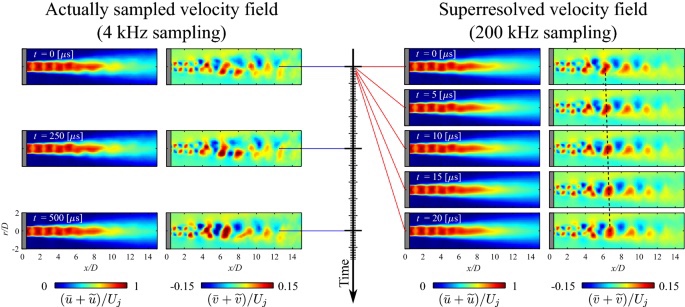

Tohoku University: Visualization of supersonic jet jets:
-Reproduce the jet at 50 times the speed of the original video-
-Reconstructed by compressed sensing-
Tohoku University
Yuta Ozawa Specially Appointed Assistant Professor
Associate Professor Taku Nonomura
We have developed a “technology to visualize the jet of a supersonic jet”.
Shoot at 4khz with a high-speed camera,
The microphone measures the sound at 200khz.
Reconstruct an image of 200Khz by combining sound and image.
The jet flow could be visualized at “50 times the speed of the original image”.
It is considered that it can be applied to various high-speed phenomena.
Reconstructed by compressed sensing:
High-speed images were reconstructed using a processing technique called compressed sensing.
First, the velocity field of the jet is photographed by the particle image velocity measurement method.
The shooting speed is 4 kHz.
Take one shot every 250 μs.
Acoustic measurement at 5 μs intervals:
In acoustic measurement, measurement is performed at 200 Khz at 5 microsecond intervals.
Reduce the dimension of measurement data,
Create a “linear regression model that associates image and sound”.
Reproduce images at 5μ second intervals:
From here, “an unphotographed image at 5 μs intervals” is created.
With this, the appearance of the vortex structure flowing was reproduced.
Not limited to jet jets, it is possible to visualize complex phenomena at high speed.
New switch
Visualize the flow of supersonic jets 50 times faster than before-expected to reduce noise pollution and structure destruction-
https://www.tohoku.ac.jp/japanese/newimg/pressimg/tohokuuniv-press20220704_03web_jet.pdf
Université du Tohoku : Visualisation des jets supersoniques :
-Reproduire le jet à 50 fois la vitesse de la vidéo originale-
-Reconstruit par détection compressée-
Université du Tohoku
Yuta Ozawa Professeur adjoint spécialement nommé
Professeur agrégé Taku Nonomura
Nous avons développé une “technologie pour visualiser le jet d’un jet supersonique”.
Filmez à 4khz avec une caméra à haute vitesse,
Le microphone mesure le son à 200khz.
Reconstruire une image de 200Khz en combinant le son et l’image.
Le flux de jet a pu être visualisé à “50 fois la vitesse de l’image originale”.
On considère qu’elle peut s’appliquer à divers phénomènes à grande vitesse.
Reconstruit par détection compressée :
Les images à grande vitesse ont été reconstruites à l’aide d’une technique de traitement appelée détection compressée.
Tout d’abord, le champ de vitesse du jet est photographié par la méthode de mesure de vitesse par image de particules.
La vitesse de prise de vue est de 4 kHz.
Prenez une photo toutes les 250 μs.
Mesure acoustique à intervalles de 5 μs :
En mesure acoustique, la mesure est effectuée à 200 Khz à des intervalles de 5 microsecondes.
Réduire la dimension des données de mesure,
Créer un “modèle de régression linéaire associant image et son”.
Reproduisez les images à des intervalles de 5 μ secondes :
À partir de là, “une image non photographiée à des intervalles de 5 μs” est créée.
Avec cela, l’apparence de la structure de vortex qui coule a été reproduite.
Non limité aux jets à réaction, il est possible de visualiser des phénomènes complexes à grande vitesse.
Nouvel interrupteur
Visualisation du flux de jet supersonique 50 fois plus rapide qu’avant – Prévu pour supprimer la pollution sonore et la destruction de la structure –
Universität Tohoku: Visualisierung von Überschalljets:
-Reproduzieren Sie den Jet mit der 50-fachen Geschwindigkeit des Originalvideos-
-Rekonstruiert durch Compressed Sensing-
Tohoku-Universität
Yuta Ozawa Speziell ernannter Assistenzprofessor
Außerordentlicher Professor Taku Nonomura
Wir haben eine „Technologie zur Visualisierung des Strahls eines Überschalljets“ entwickelt.
Nehmen Sie mit einer Hochgeschwindigkeitskamera mit 4 kHz auf,
Das Mikrofon misst den Ton bei 200 kHz.
Rekonstruieren Sie ein Bild mit 200 kHz, indem Sie Ton und Bild kombinieren.
Der Strahlstrom konnte mit “50-facher Geschwindigkeit des Originalbildes” visualisiert werden.
Es wird davon ausgegangen, dass es auf verschiedene Hochgeschwindigkeitsphänomene angewendet werden kann.
Rekonstruiert durch Compressed Sensing:
Hochgeschwindigkeitsbilder wurden mit einer Verarbeitungstechnik namens Compressed Sensing rekonstruiert.
Zuerst wird das Geschwindigkeitsfeld des Strahls durch das Partikelbild-Geschwindigkeitsmessverfahren fotografiert.
Die Aufnahmegeschwindigkeit beträgt 4 kHz.
Machen Sie alle 250 μs eine Aufnahme.
Akustische Messung im 5 μs-Takt:
Bei der akustischen Messung wird die Messung bei 200 kHz in Intervallen von 5 Mikrosekunden durchgeführt.
Reduzieren Sie die Dimension von Messdaten,
Erstellen Sie ein „lineares Regressionsmodell, das Bild und Ton verknüpft“.
Reproduzieren Sie Bilder in Intervallen von 5 μs:
Von hier aus wird “ein nicht fotografiertes Bild in 5-μs-Intervallen” erstellt.
Damit wurde das Erscheinungsbild der fließenden Wirbelstruktur reproduziert.
Nicht auf Jetjets beschränkt, ist es möglich, komplexe Phänomene mit hoher Geschwindigkeit zu visualisieren.
Neuer Schalter
50-mal schnellere Visualisierung von Überschallstrahlströmungen als zuvor – Soll Lärmbelästigung und Strukturzerstörung unterdrücken –
Spatiotemporal superresolution measurement based on POD and sparse regression applied to a supersonic jet measured by PIV and near-field microphone
SpringerLink
Abstract
The present study
proposed the framework of the spatiotemporal superresolution measurement based on the sparse regression with dimensionality reduction using the proper orthogonal decomposition (POD).The non-time-resolved particle image velocimetry (PIV) and the time-resolved near-field acoustic measurements using microphones
were simultaneously performed for a Mach 1.35 supersonic jet.
POD is applied to PIV and microphone data matrices,
and the sparse linear regression model of the reduced-order data is calculated using the least absolute shrinkage and selection operator regression.
The effects of the hyperparameters of the superresolution measurement
were quantitatively evaluated through randomized cross-validation.
The superresolved velocity field indicated the smooth convection of the velocity fluctuations associated with the screech tone,
while the convection of the large-scale structures at the downstream side was not observed.
The proposed framework
can reconstruct the unsteady fluctuation with multiple frequency phenomena,although the reconstruction is limited to the phenomena that are associated with the microphone output.
https://link.springer.com/article/10.1007/s12650-022-00855-6